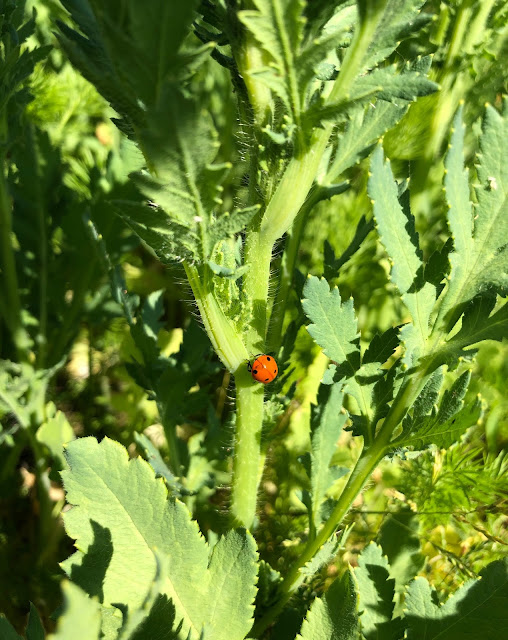
Helping the planet starts in our own space

|
|
It's always nice to see a lady beetle at work in the garden.
(Photo: Kathy Morrison)
|
I like to think that the readers of this blog are planet-aware enough to already be using earth-friendly practices with their plants and with their gardens.
So let's celebrate Earth Day today by encouraging family, neighbors or friends to try one of these easy ways to help battered old Mother Earth:
-- Compost. All those kitchen scraps and fallen leaves that end up in the green waste or (horrors!) the trash bin could be working right at home. It really doesn't take much to create the "garden gold" that enriches the soil, just organic matter, water and air. Share this composting guide .
And if someone doesn't have space for a compost bin, they can try worm composting. Worms just need a big plastic bin and some bedding material, and they'll happily transform those potato peelings and apple cores into worm castings, which are MAGIC in the garden. Here's my blog post from last fall about my worm bin. (Those red wigglers are still going strong, by the way). And here's the Sacramento County master gardeners' guide to setting up a worm bin.
-- Feed the soil. That compost? Best thing a gardener can add to problem soil. It will help lighten clay and provide structure to sand, in addition to improving the soil's water-holding capacity. That in turn helps plants send out better, stronger roots. Worm castings spread over the top of the soil will leach down and improve it, too. Helping the soil always is a win-win proposition.
-- Plant something for the beneficials. Urban life is tough on all the small but important insects that make the outdoor world work, such as hoverflies, lacewings, damsel bugs and parasitic mini-wasps.And the rock star of the group, lady beetles. Many of them dine voraciously on the "bad bugs" -- so much better than using insecticides. So add to the garden some plants that give these little insects food and resting spots. Suggestions: Flowering herbs, cosmos, yarrow and goldenrod. See this list for more ideas.
-- Switch to natural fertilizers. Fertilizers are confusing to most people, so they grab whatever seems right, whatever the source. But one of the most important things I learned last year in master gardener classes is that while plants themselves don't care where their nutrients come from, the soil will care immensely . Chemical fertilizers boost the plants -- sometimes too much -- but do little to aid the soil or the microorganisms that live there. Look for fertilizers based on natural ingredients such as fish emulsion, alfalfa meal, chicken manure, blood meal and cottonseed meal. (I'm now one of those people who stands in the nursery aisle reading package ingredients.)
-- Plant a tree. It's an Earth Day cliché, but that's because it's true. Trees clean the air, anchor the soil, give shelter to birds and other wildlife, and provide shade to homes and gardens. Even a small one helps. The Sacramento Tree Foundation would be happy to help anyone choose the right tree .
Bonus way to celebrate that anyone can do: Take 5 minutes to discover something new in your garden. Explore the shapes of the oak leaves or marvel at the color gradations in a flower petal. It's an astonishing world and we are so lucky to be its caretakers.
Comments
0 comments have been posted.Sacramento Digs Gardening to your inbox.
Food in My Back Yard Series
May 6: Maintain soil moisture with mulch for garden success
April 29: What's (already) wrong with my tomato plants?
April 22: Should you stock up on fertilizer? (Yes!)
April 15: Grow culinary herbs in containers
April 8: When to plant summer vegetables
April 1: Don't be fooled by these garden myths
March 25: Fertilizer tips: How to 'feed' your vegetables for healthy growth
March 18: Time to give vegetable seedlings some more space
March 11: Ways to win the fight against weeds
March 4: Potatoes from the garden
Feb. 25: Plant a fruit tree now -- for later
Feb. 18: How to squeeze more food into less space
Feb. 11: When to plant? Consider staggering your transplants
Feb. 4: Starting in seed starting
Sites We Like
Garden Checklist for week of May 11
Make the most of the lower temperatures early in the week. We’ll be back in the 80s by Thursday.
* Plant, plant, plant! It’s prime planting season in the Sacramento area. Time to set out those tomato transplants along with peppers and eggplants. Pinch off any flowers on new transplants to make them concentrate on establishing roots instead of setting premature fruit.
* Direct-seed melons, cucumbers, summer squash, corn, radishes, pumpkins and annual herbs such as basil.
* Harvest cabbage, lettuce, peas and green onions.
* In the flower garden, direct-seed sunflowers, cosmos, salvia, zinnias, marigolds, celosia and asters. (You also can transplant seedlings for many of the same flowers.)
* Plant dahlia tubers.
* Transplant petunias, marigolds and perennial flowers such as astilbe, columbine, coneflowers, coreopsis, dahlias, rudbeckia and verbena.
* Keep an eye out for slugs, snails, earwigs and aphids that want to dine on tender new growth.
* Feed summer bloomers with a balanced fertilizer.
* For continued bloom, cut off spent flowers on roses as well as other flowering plants.
* Add mulch to the garden to maintain moisture. Mulch also cuts down on weeds. But don’t let it mound around the stems or trunks of trees or shrubs. Leave about a 6-inch-to-1-foot circle to avoid crown rot or other problems.
* Remember to weed! Pull those nasties before they set seed.
* Water early in the day and keep seedlings evenly moist.